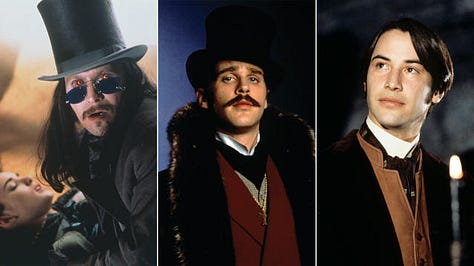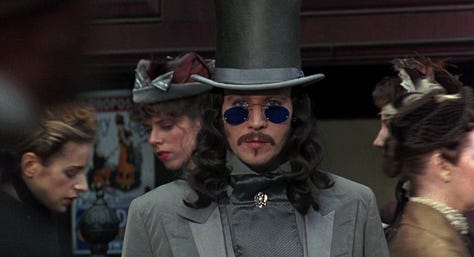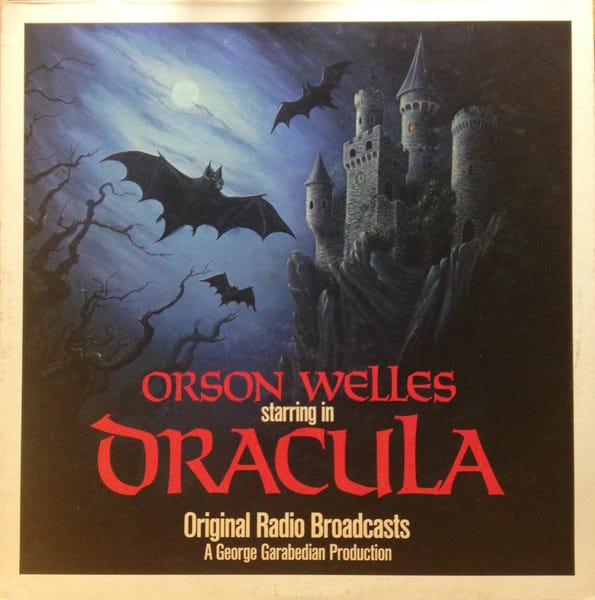BRAM STOKER'S DRACULA (1992) - The Movie That Rescued a Winery
It produced rivers of blood on the studio lot and rivers of wine for the Coppola Family.
Most of us are aware that filmmaker Francis Ford Coppola is super into wine.
We've seen his "Diamond Collection", Coppola-branded bottles absolutely everywhere wine is sold - grocery stores, convenience stores, big box stores, and even (*gasp!*) actual wine shops. It's ubiquitous!
But it didn't start that way.
Niebaum-Coppola Vineyard (1975)
Coppola - the filmmaker who took his crew into the jungles of the Philippines for a 238 day shoot fueled by alcohol, drugs, and mental disorders (see the HEARTS OF DARKNESS documentary about that APOCALYPSE NOW shoot, one of the best behind-the-scenes features ever made, full stop) - is known for taking big risks.
In 1975, coming hot off the success of THE GODFATHER, THE COVERSATION, and THE GODFATHER PART II1, Coppola was flush with cash and purchased the Gustave Niebaum vineyard in Napa County. The vineyard was the very first in California to gain international recognition for quality wines, winning gold medals at the World's Fair of Paris in 1889 (!) and under the brand "Inglenook" it continued to win medals and recognition at home.
For nearly 100 years, Inglenook's motto was "Pride, Not Profit," and its operations were often subsidized by the personal fortunes of its owners. So much so, that by 1964 financial distress impelled the family to sell the name and 166 acres of the vineyard to The Allied Grape growers, who then sold it to the Heublin Corporation. After which "Inglenook" became synonymous with mass produced cheap jug wine.
Thankfully, Coppola's purchase of the remaining acreage of the vineyards and the estate itself allowed him to bring quality and prominence back to the vineyard's grapes under a new label, "Neibaum-Coppola"; while he had the vineyard, he couldn't afford the "Inglenook" brand, which remained in corporate ownership and continued to be slapped on mass-production wines.
Debt, Debt, Bankruptcy, and More Debt
As the 70's came to an end and the 80's began, Coppola's fortunes turned on a dime. After one last cultural sensation with APOCALYPSE NOW (1979), Coppola's seemingly magic ability to create singular hits at the box office abruptly stopped, starting with the director's biggest misstep of his career in 1982.
ONE FROM THE HEART was a musical romantic drama originally meant to be produced by MGM, who offered Coppola $2M to direct. Coppola decided it was an offer he could refuse and declined; he instead bought the rights to the property through his Zoetrope Studios and MGM became merely the distributor. The studio fully pulled out, however, when the budget ballooned from $15M to $23M.
Coppola insisted on shooting the entire film on soundstages (remember that bit, it'll come back into play when we hit Dracula.) Miniatures and lavish backgrounds, huge musical numbers with Gene Kelly choreography, a soundtrack by Tom Waits and Crystal Gale. Paramount came on board as distributor, then backed out at the 11th hour, when press screenings were not well received. Zoetrope was struggling to stay solvent, with the crew working for reduced wages and an emergency influx of $8M investment necessary during production.
Columbia Pictures agreed to distribute the film mere weeks before it was set to be released. The film made an abysmal $339 thousand on its opening weekend on 41 screens, and ended at only $636,796. Total. Against a $26 MILLION budget. Coppola was personally on the hook for a large portion of it.
He was forced to declare bankruptcy for Zoetrope Studios - the storied production company behind George Lucas' pre-Star Wars films amongst many others. He would later reincorporate as "American Zoetrope" (which continues to this day.)
But the 80's were no kinder to Coppola - THE OUTSIDERS, RUMBLE FISH, and THE COTTON CLUB were all sizeable box office bombs. His one hit was PEGGY SUE GOT MARRIED starring Kathleen Turner and his nephew, Nicholas Cage. But that was followed by another string of misfires, GARDENS OF STONE and TUCKER: THE MAN AND HIS DREAM.
Do or Die: Two Hits In a Row or Sell the Estate and Vineyard
By 1990, Coppola was once again very pressed for cash, and his debts had dogpiled to the point of insolvency. He got a rescue line in the form of THE GODFATHER PART III2, which made $136M on a $56M budget - finally a box office success! But it was nevertheless a disappointment compared to the previous entries, and didn’t earn enough to clear Coppola’s books. So his next project was going to be crucial: if he couldn't manage a second hit in a row - something he hadn't managed since the mid-70's - he'd be forced to sell his Neibaum-Coppola estate and vineyard to pay off his mounting, remaining debts.
It was Winona Ryder who brought the Dracula script to him. She wanted to know if he thought she could pull off the part of Mina - she was looking for something different from the teen movie roles she’d been cast in up to that point. Winona was afraid she and Coppola were on bad terms because she had to drop out of THE GODFATHER PART III at the last minute, to be replaced by Sofia Coppola - a non-actress who had zero time to prepare and who the critics then excoriated for her performance.
But DRACULA was one of Coppola's favorite stories as a younger man, when he would read the story to 9-year-olds as a camp counselor to get them to sleep quickly so he could go get it on with his girlfriend in a different camp. I can't say for sure that this is the reason Coppola thought of Dracula as a romantic and erotic tale, but the condom sure does fit. (sorry not sorry)
The project was written by the writer of Spielberg's HOOK, James V. Hart, and was set to be a cable TV movie before Coppola came aboard. Coppola believed in something that Orson Wells had said many years back, when the legendary actor/director adapted Dracula as a radio play - that anyone wanting to adapt the story in the future should go back to the original text of the novel, and not the stage play, which is what most adaptations had done up until that time, including Universal's Dracula movies.
The movie that Coppola set out to make is thus fairly faithful to the novel, except for one major difference - he made it a love story! Dracula, in the novel, is without question the villain. A monster of the highest order who wants to spread his vampiric disease across the globe. Coppola gave his backstory a tragic, romantic twist and had his pursuit of Winona Ryder's Mina be about "crossing oceans of time" to be reunited with his reincarnated lover. Hence Coppola’s steamy condom-fitting approach to the material.
But that wasn't all: the original novel came out in 1897, just as "moving pictures" were getting started, so Coppola thought: What if we made the film like they might make it in 1897?
Which brings us back full circle to: soundstages! All of BRAM STOKER'S DRACULA3 was shot on stages, nothing on location, much as Coppola had done for the biggest bomb of his career, ONE FROM THE HEART. He refused to use any computer-generated visual effects - even though this era was the rise of such effects, with TERMINATOR 2 dropping that same year and JURASSIC PARK dropping the next. But for Dracula, all the effects would be practical.
That all said, Coppola was DETERMINED to come in on budget and on time, unlike nearly all his previous films. Shooting on stages within the studio lot would allow the studio to oversee and control the production in full, which was something Coppola actually desired this one time only.
But he was still Coppola - he fired numerous department heads well into pre-production, including his entire VFX team (who didn't think they could do all he wanted without digital effects) and his production designer, who wasn't thrilled when Coppola demanded that the sets be sparse, minimalist - he wanted the costumes to be the meat of the design in the movie.
As Costume Designer, he hired Eiko Ishioka, the lady who designed the Japanese APOCALYPSE NOW poster back in the late 70’s, but who wasn’t a costume designer! This particular gamble paid off, however, as Ishioka snagged an Oscar for her costumes in DRACULA. For her very first time as a costume designer!


The cast came together quickly - Winona Ryder as Mina, Gary Oldman as Dracula (in his first leading role in an American film), Anthony Hopkins as Van Helsing, though the character of Jonathan Harker was the one hitch. Coppola wanted Ryder's boyfriend at the time, Johnny Depp. The two had just co-starred together in EDWARD SCISSORHANDS. But the studio rejected Depp, stating he wasn't a big enough draw. They ultimately agreed on Keanu Reeves, a casting that occurred last minute giving Keanu little time to prepare. (Trends!)
The shoot wasn't as problematical as Coppola's APOCALYPSE NOW (but really, what has been!) Yet a few sticky bits: Oldman quickly alienated the rest of the cast. He refused to break character at any time. He would sleep in coffins every night, never socialize, and flitter about the set hissing lines at them at random. He was also a raging alcoholic throughout. (He was going through a divorce.) As he would later say: "I sweat vodka in those days."
At one point, Oldman and Ryder had a full-on falling out and refused to speak to the other. To this day, Coppola has no idea what happened, and neither actor was willing to speak about it, though both have since buried that particular hatchet and are on good terms in the present. But for the rest of the shoot, they refused to interact outside of what was absolutely necessary.
The film required so many practical effects, and was so thick with fake blood needs, that at one point the production designer, while heading to work on the studio lot, happened upon LITERAL RIVERS OF BLOOD gushing between soundstages and when he got to set he was stunned to realize it was coming from his own movie!





Moment of Truth
Despite all of the above, Coppola did in fact turn in the movie on time and on budget (hallelujah!), costing $40M total. A price tag that sounds quaint by 2024 standards, but was a sizeable movie budget for 1992.
Critical reception prior to the wide release was mixed - the visuals were praised while the story and some of the performances were questioned. But Coppola had done what he could; he took his family on vacation and refused to look at the news during opening weekend; whatever would be, would be.
His wife brought him the numbers from the trade news at the end of the weekend: #1 at the box office with a $30M opening domestic weekend. It was a record for November releases at the time! It would go on to make $82M domestically, and a whopping $218M worldwide. Coppola was back as a hitmaker!
Wine Legacy
Flush with cash and work offers, Coppola not only paid off his debts and continued to own the Niebaum vineyard and his Niebaum-Coppola brand, he was *finally* able to purchase the Inglenook brand! Believe it or not, it cost more than the entire Niebaum vineyards and estate combined. Just to buy the NAME.
Since 1995, Inglenook has once again been a brand of quality, producing only wines by the Niebaum-Coppola group. They even released a DRACULA 1991 vintage in celebration!
And there you have it: BRAM STOKER'S DRACULA, the film that rescued a winery and allowed Coppola to build his wine portfolio even beyond Niebaum vineyards in the years to come - including the Oregon winery, Domaine Lumineux4. None of which would have been possible if Dracula hadn't been a box office success.
Whew! Wine and Entertainment are not for the weak of heart! Either or both can drive a stake through anyone’s at a moment's notice!
This was the first movie to ever use a "Part II" or any sort of numerical ordering in its title. Believe it or not, Hollywood had historically been opposed to EVER putting a number in a title, believing audiences had little reason or care to watch a second part if they'd already seen a first.
This time, ironically, Coppola and Mario Puzo wanted to call the movie "The Death of Michael Corleone" and not “Part III” but the studio insisted on the numerical sequencing! Hollywood is nothing if not calcified thinking on whatever has last proven successful, and being against whatever hasn't yet been done or hasn’t been done in a while. “Never change” is always the motto. Always. Even though the next big thing is always something new.
The movie was called the full “Bram Stoker’s Dracula” because Universal had the rights to the title/name “Dracula” as part of their Universal monster universe, but they had never secured the rights to the book!











Love the movie, and was unaware of much of this backstory! I think both Reeves and Ryder were weak links here (despite liking them otherwise). Just simple miscasting. But not devastating enough to ruin the movie at all, somehow.
Great film (though not the biggest fan of the Mina/Dracula romance)